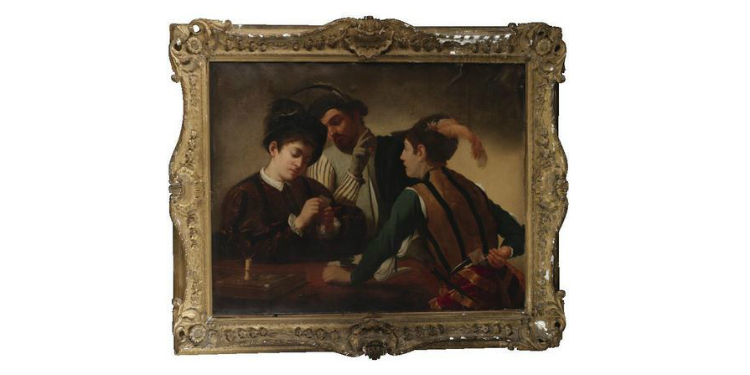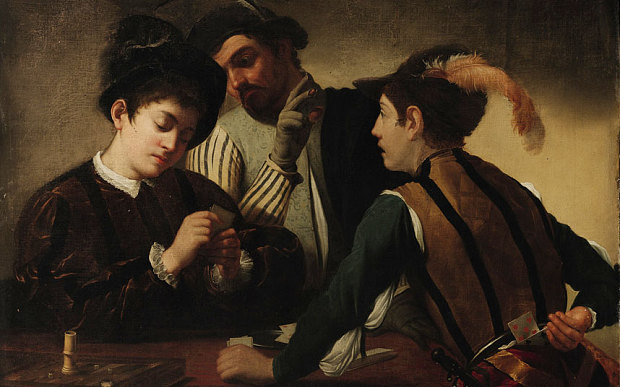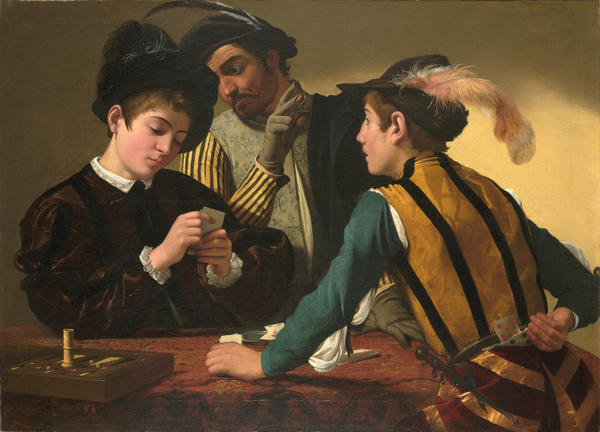Thwaytes v Sotheby’s: Caravaggio’s Cardsharps?

Sir Denis Mahon 's version of The Cardsharps originally owned by Lancelot Thwaytes.
The story behind the Caravaggio’s Cardsharps Sotheby’s trial
“Words cannot really do my emotions justice.” Lancelot Thwaytes was speaking about the day he heard that a painting he sold at Sotheby’s for £42,000, had been claimed to be an original Caravaggio worth more than £10 million. Sotheby’s sold the work as being by a “Follower of Micheangelo Merisi Da Caravaggio”.
After getting over what he described as his “horror,” Thwaytes, decided to sue Sotheby’s for what he saw as negligent handling of the work. He said that Sotheby’s experts had failed to adequately research the painting and had also failed to notice certain features that should have identified the work as by Caravaggio.
The case, which was decided by the High Court in Sotheby’s favour, demonstrates the issues surrounding attribution of an artwork. In this case, the auction house – and many other experts – continue to believe that the painting is not by Caravaggio. A leading expert – who bought the painting – was certain it should be attributed to the artist.
“This case highlights the complexities of valuing art and the importance of the expression of unfettered expert opinion in shaping the art market,” said Karen Sanig, Head of Art Law at Mishcon de Reya. “This is especially so where there is no clear consensus on attribution.”
“This case highlights the complexities of valuing art and the importance of the expression of unfettered expert opinion in shaping the art market,”
The Musicians and the Kimbell Cardsharps
The story of Thwaytes’ Cardsharps is intertwined with two other Caravaggio works – The Muscians, now in the Metropolitan Museum of Art, and another picture called the Cardsharps in the Kimbell Art Museum in Fort Worth, Texas.
Thwaytes inherited the painting from his father’s cousin Surgeon Captain William Glossop Thwaytes when he died in 1965. Captain Thwaytes was an avid collector with a particular interest in Caravaggio.
Captain Thwaytes was a knowledgable collector and in the 1950s he managed to get one of his pictures The Musicians identified as an original artwork by the hand of Caravaggio. He was helped in this process by Sir Denis Mahon. Mahon was one of the world’s most highly regarded Italian Baroque art historians and collectors and a recognised Caravaggio specialist.
Mahon wrote the monograph that argued The Musicians was an original Caravaggio. In the January 1952 edition of Burlington Magazine he explained how he had seen a photograph of a picture and felt it had potential to be an original.
This was a significant discovery. Only around 60 Caravaggio paintings are known to exist and although Caravaggio trained in a studio he did not have his own school of students or followers.
After the painting had been established as a Caravaggio, Captain Thwaytes sold The Musicians to the New York’s Metropolitan Museum of Art.
Captain Thwaytes continued collecting and in 1962 he bought a painting called the The Cardsharps for £140 at a Sotheby’s auction. The work was catalogued as “Caravaggio (After), The Cardplayers” indicating that they felt the work was a copy of an existing Caravaggio piece. In this case it was thought to be a copy of an original work – I Bari -that Caravaggio painted around 1595 for his patron Cardinal Francesco Maria del Monte. The painting was lost from the market in 1890 – when it was photographed – before being re-discovered in 1987 at the Zurich Institut für Kunstwissenschaft. Professor Mina Gregori, one of the most highly regarded Italian art historians, realised it was an original by the master. Mahon was also involved in the decision. Writing in The Burlington Magazine he said: “It did not take me very long – sceptical as I have always been on the subject – to convince me.” His views helped confirm that the Kimbell Cardsharps was by Caravaggio.

Sir Denis Mahon’s version of ‘The Cardsharps’ originally owned by Lancelot Thwaytes. Photo: Sotheby’s

Michelangelo Merisi da Caravaggio ‘The Cardsharps’ currently on display at the Kimbell Museum, Fort Worth, Texas. Photo: Kimbell Museum
Selling the painting
Lancelot Thwaytes kept his version of The Cardsharps until 2006 when he decided to sell it. In April 2006, Matthew Barton, a valuer at Sotheby’s visited Thwatyes and discussed its possible valuation.
Several meetings of Sotheby’s Old Master Paintings specialists to discuss the work took place, as well as in-depth inspection by Tom Baring, the individual assigned to research and catalogue the painting. [Baring later rose to deputy director of Old Master Paintings before launching Baring Fine Art].
Baring compared the painting with the Kimbell Cardsharps and felt it was a copy. After examining the work, he called Thwaytes and informed him of the unanimous decision that the work painting was not an original autograph work. At this point Thwaytes requested that x-rays should be taken. These were done. However, after examining them Sotheby’s did not change their decision.
Sotheby’s estimated the pre-sale value of Thwaytes’ Cardsharpsat between £20,000-£30,000. It was agreed to sell the picture during Old Masters’ Week in Sotheby’s Olympia auction room, which closed in 2007.
The catalogue attributed the painting to a “follower of Michelangelo Merisi da Caravagio The Cardsharps.”
The catalogue also added: “Surgeon Captain W.G Thwaytes was a very keen and important collector of compositions by Caravaggio, and indeed sold Caravaggio’s original of The Musicians to the Metropolitan Museum of Art, New York.”
During the pre-sale exhibition, the painting received a lot of attention. Due to this interest, Baring asked Alexander Bell, joint international head and co-chairman of Sotheby’s Old Master Paintings Department, to examine the work as an extra precaution. Bell and two colleagues – including Christopher Apostle, head of the Old Masters Paintings Division in Sotheby’s New York, examined the painting. They all agreed that it was not an original.
The painting sold for £42,000, plus buyer’s commission. The underbidder was a consortium of dealers. Thwaytes received £34,468 after commission
Sir Denis Mahon challenges
The winning bidder was Orietta Benocci Adam, a banker and close friend of Mahon – the expert who had championed Captain Thwayte’s Muscians and the Kimbell Cardsharps. She bought the picture as a gift for Mahon.
Mahon arranged for the painting to be cleaned and restored. He also arranged for infrared imaging to take place and showed the work to other specialists in Caravaggio. One of these was Professor Mina Gregori, who had discovered The Cardsharps now in the Kimbell Art Museum.
At his 97th birthday party in 2007, Mahon shocked the art world by announcing that the work was an autograph replica painting by Caravaggio.
In 2008 the work was put on display in Italy, described as an autograph work by Caravaggio.
Mahon died in 2011 and left his collection of 57 paintings to six UK galleries and museums. Since Mahon’s death the Carsharps has been on display at the Museum of the Order of St John in Clerkenwell in London.
Thwaytes and the dispute with Sotheby’s
After hearing Mahon’s announcement, Thwaytes, understandably, wrote to Sotheby’s.
Sotheby’s disputed Mahon’s claim. “We studied the painting here carefully for a period of three and a half months before the catalogue went to press and arranged for x-rays to be made of it,” said Bell who had examined the painting at Olympia. “We remain confident in our opinion, from our research and from the study of these x-rays, that the painting is not by Caravaggio”
“We remain confident in our opinion, from our research and from the study of these x-rays, that the painting is not by Caravaggio”
Thwaytes called his lawyers.
The case ended up in the English High Court in front of Justice Rose on October 27 2014. The proceedings took 17 days. Henry Legge QC and Andrew Bruce represented Thywates, who was advised by Boodle Hatfield. Andrew Onslow QC and Richard Edwards acted for Sotheby’s and its law firm Freshfields.
Sotheby’s called five witnesses, two Sotheby’s employees, including Bell the Joint Co-Chairman of Sotheby’s Old Master Painting Department. Thwaytes was the primary witness for his own case, with a statement assessing the painting from Professor Mina Gregori.
In its defence, Sotheby’s counsel pointed to the fact that there are several dozen known copies of the work by other artists in existence. Using data from auction price provider Artnet, counsel showed that at least 30 different versions of The Cardsharps had been sold at auction between 1988 and 2012. The Thwaytes family had handled four of these. Surgeon Thwaytes had also left two other versions of The Cardsharps to Thwaytes, whose own father had purchased yet another version in the 1970s.
Thwaytes said that he was given the impression that an infra-red study of the work would be done. Barton, the original valuer, denied this. The judge wondered whether there might have been confusion between the parties as to what testing would be carried out on the painting.
Thwaytes also said that this painting should have received special inquiry and further research into its attribution due to its importance and the quality. This was particularly so as Captain Thwaytes’ collection had included The Musicians. Judge Rose disagreed dismissing this point saying: “there are no special features in this case to extend that duty or make it more onerous”.
Sotheby’s main argument was that the quality of the painting gave no suggestion that any further steps were required. Speaking in court, Bell said: “Our main consideration in assessing a painting is quality. In the case of a painting suggested to be a copy of a work by a known artist, we will consider whether the painting being viewed is of the quality expected of a painting by that artist”.
Sotheby’s also pointed out Mahon was 96 when the painting came into his possession, and his judgement – particularly his ability to correctly assess the quality and authorship of a painting – was questioned. It was said during the trial that experts other than Sotheby’s had also questioned the state of Mahon’s faculties.
Why Sotheby’s won
Judge Rose found for Sotheby’s. She said “If Sotheby’s are confident that a painting is right then they will catalogue the painting accordingly though they will refer to contrary views expressed by others. Similarly if they are convinced that a painting is not right they will not catalogue it more optimistically”.
The judge found no reason why Sotheby’s should have questioned the origin of the painting, and they said that they were justified to rely on the expertise of their employees. No fault was found in the reading of the x-rays by Sotheby’s specialists, and there was no obligation by the auction house to undertake any Infrared imaging of the works.
Rose noted that, although Mahon had positively attributed the painting to Caravaggio, had Sotheby’s consulted with other experts, there would have been more negative responses than positive. Hence the work would still not have been identified in the catalogue as an autograph original, and Thwaytes had therefore not necessarily lost out.
Overall it was decided that Sotheby’s were not negligent in their practices and that they had fulfilled their duty in assessing and examining the artwork to provide an accurate description in the catalogue. They also completed the normal process for consigning a work of this type, relative to their knowledge and assessment of the painting.
“The judge concluded that Sotheby’s was not negligent and that the Sotheby’s Old Master Painting specialists who assessed the work were ‘highly qualified,’ examined the painting ‘thoroughly,’ and reasonably came to the view that the quality of the painting was ‘not sufficiently high’ to merit further investigation.” The judge praised the “exemplary way in which this fascinating case was presented at trial.”
“The judge concluded that Sotheby’s was not negligent”
After the trial Sotheby’s released a statement stating: “Sotheby’s is delighted that today’s ruling dismisses all claims brought against the company and confirms that Sotheby’s expertise is of the highest standards.”
However a spokesman for Thwaytes’ legal team said “Thwaytes is extremely disappointed with the decision delivered this morning and maintains that Sotheby’s failed to spot the painting’s potential.
“He brought the case following the public announcement that the painting was an autograph replica painted by the hand of Caravaggio; a view which was supported by a number of leading experts, including Mina Gregori and Sir Denis Mahon.” Thwaytes and his legal team are considering an appeal.
Lancelot Thwaytes v Sotheby’s [2015] EWHC 36 (Ch)